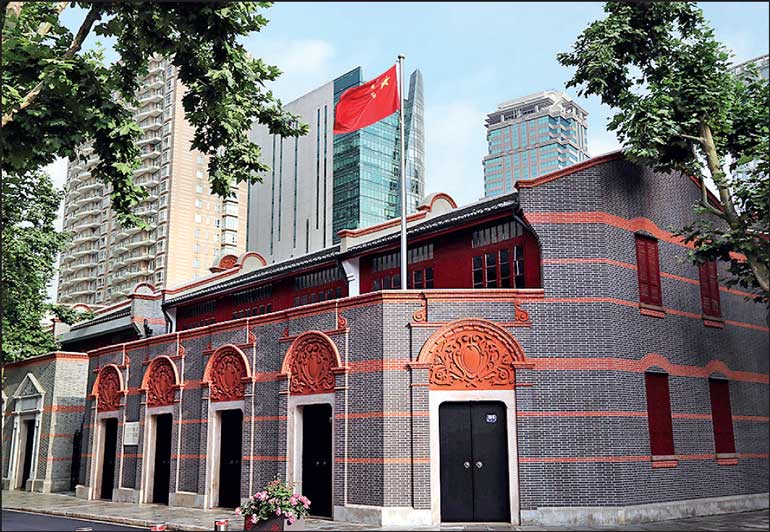Sunday Apr 20, 2025
Sunday Apr 20, 2025
Friday, 27 September 2024 00:30 - - {{hitsCtrl.values.hits}}

 Sri Lanka and China have shared a deep and enduring bond for decades, a relationship built on mutual respect, shared values, and a vision for cooperative development. Since diplomatic relations were established in 1957, the two countries have forged an unshakable partnership that continues to thrive today. Over the years, this partnership has been marked by close political ties, economic collaboration, and cultural exchanges, contributing significantly to the growth and prosperity of both nations.
Sri Lanka and China have shared a deep and enduring bond for decades, a relationship built on mutual respect, shared values, and a vision for cooperative development. Since diplomatic relations were established in 1957, the two countries have forged an unshakable partnership that continues to thrive today. Over the years, this partnership has been marked by close political ties, economic collaboration, and cultural exchanges, contributing significantly to the growth and prosperity of both nations.
The foundation of China-Sri Lanka relations was laid with Sri Lanka’s early recognition of the People’s Republic of China in 1950, just one year after the new Chinese government was founded. At a time when many nations hesitated, Sri Lanka’s decision to acknowledge the legitimacy of China’s new government demonstrated a spirit of independence and foresight. This initial act of recognition paved the way for the establishment of formal diplomatic ties on 7 February 1957, with Chinese former Premier Zhou Enlai playing a pivotal role in nurturing the relationship.
Zhou Enlai’s visits: Forging a strong foundation
Chinese Premier Zhou Enlai’s visit to Sri Lanka in 1957 marked a turning point in bilateral relations. During this landmark visit, Premier Zhou established a personal rapport with Sri Lanka’s Prime Minister S.W.R.D. Bandaranaike and his wife Sirimavo Bandaranaike. This friendship became a lasting symbol of goodwill between the two nations. Premier Zhou returned to Sri Lanka in 1964, this time accompanied by Vice Chairwoman Soong Ching-ling and Vice Premier Chen Yi, further strengthening the ties between the two countries. These diplomatic engagements laid the groundwork for a relationship that has endured for over six decades. His personal bond with the Bandaranaike family is particularly remembered as a symbol of the deep-rooted friendship between China and Sri Lanka. Sirimavo Bandaranaike, who later became the world’s first female prime minister, visited China three times during her tenure, underscoring the importance of the relationship. After her visit in the 1970s, she lauded China’s spirit of self-reliance and nation-building, calling China-Sri Lanka relations a “model of friendly cooperation” and an example for other nations to follow.
High-level exchanges: Strengthening diplomatic ties
Since the initial meetings between Premier Zhou Enlai and Sri Lankan leaders, high-level exchanges have continued to play a crucial role in cementing the bilateral relationship. Chinese leaders who have visited Sri Lanka over the years include Vice Chairman Xu Xiangqian in 1973, Vice Chairwoman Deng Yingchao in 1977, Vice Premier Geng Biao in 1978, Vice Premier and Foreign Minister Huang Hua in 1981, and State Councillor and Foreign Minister Wu Xueqian in 1985. Each of these visits reinforced the importance of China-Sri Lanka relations and highlighted the shared commitment to cooperation and development.
In recognition of the deep and lasting ties between the two nations, China has played a significant role in supporting Sri Lanka’s development through infrastructure projects, aid, and technical expertise. A testament to this is the Bandaranaike Memorial International Convention Hall, which was built with unconditional assistance from the Chinese government. The hall remains a symbol of China’s commitment to Sri Lanka’s growth and development, and it serves as a venue for international diplomacy and cooperation, hosting numerous international events that bring countries together.
Economic cooperation: The Rice-Rubber Pact and beyond
One of the most significant milestones in China-Sri Lanka relations is the “Rice-Rubber Pact” of 1952, a landmark agreement that paved the way for enhanced cooperation between the two nations. Signed amidst a challenging global political climate, the pact allowed Sri Lanka to trade rubber for Chinese rice at a time when the island nation faced economic difficulties due to a shortage of food supplies. This agreement not only addressed Sri Lanka’s immediate needs but also laid the foundation for a long-term economic partnership between the two countries.
Over the decades, China-Sri Lanka economic cooperation has evolved into a multifaceted partnership that encompasses a wide range of sectors, from infrastructure development to technology and trade. In 2005, the two nations established a comprehensive cooperative partnership, emphasising sincere mutual assistance and everlasting friendship. This partnership was further elevated in 2013 when both sides announced the upgrade of our relationship to a strategic cooperative partnership, reaffirming our commitment to working together for mutual benefit.
In 2014, President Xi Jinping paid a historic state visit to Sri Lanka, marking another high point in bilateral relations. During this visit, the two countries reached a series of agreements on cooperation under the framework of China’s “21st Century Maritime Silk Road” initiative. This initiative has brought about significant projects that have the potential to transform Sri Lanka’s economic landscape, including the CHEC Port City Colombo and the comprehensive development of Hambantota Port. These large-scale infrastructure projects are expected to serve as engines of economic growth, driving Sri Lanka’s development in the years to come.
Other key projects born from China-Sri Lanka cooperation include the Puttalam Power Plant, the Moragahakanda Reservoir, the Kaluganga Dam, the Southern Expressway, the Central Expressway, and the Southern Railway. These projects are not only reshaping Sri Lanka’s infrastructure but are also creating thousands of jobs for local communities, fundamentally altering the development prospects of the nation. China’s assistance, training programs, and management expertise are helping to build the foundation for Sri Lanka’s future, empowering its people and providing new opportunities for economic growth.
A friendship rooted in history: The symbolism of tree planting
One of the most enduring symbols of the friendship between Sri Lanka and China can be found in the Royal Botanic Gardens of Peradeniya, located in the central highlands near Kandy. During visits by Chinese leaders over the years, three trees were planted in the gardens by Premier Zhou Enlai, Vice Chairman Xu Xiangqian, and Vice Chairwoman Deng Yingchao. These trees, planted decades ago, continue to thrive, serving as living symbols of the deep-rooted friendship between the two nations.
Although the revolutionary leaders who planted these trees are no longer with us, their legacy endures. The trees, still flourishing with vitality, are a testament to the strength and longevity of China-Sri Lanka relations. They stand as a reminder that while individuals may pass, the bonds of friendship between nations can grow stronger with time. Just as these trees continue to grow, so too does the friendship between Sri Lanka and China, which remains vibrant and full of life.
Looking to the future: A partnership for the new era
As Sri Lanka and China move forward into the future, our partnership remains as strong as ever, built on a foundation of mutual trust, respect, and shared interests. The relationship has grown and evolved over the years, adapting to the changing global landscape and the needs of both nations. Today, China plays a pivotal role in Sri Lanka’s economic development, providing much-needed support through investments in infrastructure, technology, and human resources.
The two nations have also deepened our cooperation in international forums, working together to address global challenges such as climate change, poverty alleviation, and sustainable development. Sri Lanka and China share a common vision of creating a more just and equitable world, where nations can work together to achieve prosperity and peace.
As we enter a new era of China-Sri Lanka relations, the longstanding friendship between the two countries continues to grow, reaching new heights and opening up new opportunities for collaboration. The projects that have already been completed, such as the CHEC Port City Colombo and the Southern Expressway, are just the beginning of what promises to be a long and fruitful partnership. As China and Sri Lanka work together to build a better future, our friendship remains a shining example of what can be achieved when nations come together in the spirit of cooperation and mutual respect.
In conclusion, the relationship between Sri Lanka and China is one of the most enduring and successful partnerships in modern diplomacy. Rooted in a shared history and strengthened by mutual support, this partnership continues to thrive, offering a model for other nations to follow. As both countries look to the future, our friendship will remain a cornerstone of our foreign policies, guiding us toward a brighter, more prosperous tomorrow.
(The writer is Sri Lanka’s Consul General in Shanghai, People’s Republic of China)
Discover Kapruka, the leading online shopping platform in Sri Lanka, where you can conveniently send Gifts and Flowers to your loved ones for any event including Valentine ’s Day. Explore a wide range of popular Shopping Categories on Kapruka, including Toys, Groceries, Electronics, Birthday Cakes, Fruits, Chocolates, Flower Bouquets, Clothing, Watches, Lingerie, Gift Sets and Jewellery. Also if you’re interested in selling with Kapruka, Partner Central by Kapruka is the best solution to start with. Moreover, through Kapruka Global Shop, you can also enjoy the convenience of purchasing products from renowned platforms like Amazon and eBay and have them delivered to Sri Lanka.
Discover Kapruka, the leading online shopping platform in Sri Lanka, where you can conveniently send Gifts and Flowers to your loved ones for any event including Valentine ’s Day. Explore a wide range of popular Shopping Categories on Kapruka, including Toys, Groceries, Electronics, Birthday Cakes, Fruits, Chocolates, Flower Bouquets, Clothing, Watches, Lingerie, Gift Sets and Jewellery. Also if you’re interested in selling with Kapruka, Partner Central by Kapruka is the best solution to start with. Moreover, through Kapruka Global Shop, you can also enjoy the convenience of purchasing products from renowned platforms like Amazon and eBay and have them delivered to Sri Lanka.